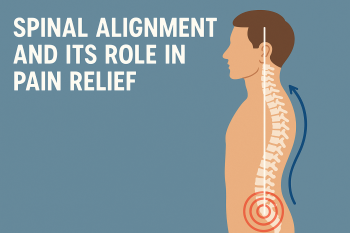
When most people think about balance, they imagine standing upright or walking without stumbling. But balance is a complex function of the body, largely controlled by the vestibular system. This system, housed in the inner ear and brainstem, is responsible for detecting motion, spatial orientation, and equilibrium. When it malfunctions, the result can be dizziness, vertigo, unsteadiness, or even nausea.
For many patients, vestibular disorders are life-changing, impacting daily activities and quality of life. Conventional care often focuses on symptom management through medications, vestibular rehabilitation, or surgery in more severe cases.
However, there is a growing awareness of the connection between spinal alignment—especially in the upper cervical spine—and vestibular health. This is where upper cervical chiropractic care enters the conversation as a natural, non-invasive solution.
Understanding Vestibular Disorders
The vestibular system consists of the inner ear organs (semicircular canals, utricle, and saccule) and their neural connections to the brainstem and cerebellum. Together, they detect head movements and position changes, sending information to the brain to maintain equilibrium.
When this system is disrupted, patients may experience:
- Vertigo – a false sensation of spinning or movement.
- Dizziness or lightheadedness – often unpredictable and debilitating.
- Balance problems – difficulty walking straight or standing upright.
- Nausea and vomiting – secondary symptoms of disorientation.
- Visual disturbances – such as blurred or jumpy vision during head movements.
Common vestibular disorders include Ménière’s disease, benign paroxysmal positional vertigo (BPPV), vestibular neuritis, and chronic dizziness. While each has its own root cause, they all share one thing in common: impaired communication between the inner ear, brainstem, and central nervous system.
The Link Between the Upper Cervical Spine and the Vestibular System
The upper cervical spine, consisting of the atlas (C1) and axis (C2) vertebrae, plays a critical role in neurological function. These vertebrae protect the brainstem, which is a hub for neural communication—including signals from the vestibular system.
When the atlas or axis becomes misaligned, it can interfere with nerve pathways and blood flow to the brain. Even small misalignments can have far-reaching effects on balance, spatial awareness, and coordination. Research and clinical reports suggest that correcting these misalignments may help restore normal vestibular function and reduce the intensity or frequency of dizziness and vertigo.
How Upper Cervical Care Works
Unlike general chiropractic adjustments that may involve twisting or popping, upper cervical chiropractic care uses a highly precise and gentle approach. Practitioners focus specifically on the alignment of the atlas and axis, often using advanced imaging and analysis to locate even the smallest deviations.
The process typically involves:
- Assessment and Imaging – X-rays or digital scans are taken to evaluate alignment and structure.
- Customized Adjustment – A gentle, calculated correction is applied to realign the upper cervical vertebrae.
- Monitoring and Follow-up – Progress is tracked over time, with additional adjustments provided only as necessary.
Because the correction is precise, many patients report long-lasting changes after just a few adjustments. For those suffering from vestibular disorders, this can mean fewer dizzy spells, improved balance, and restored confidence in daily life.
Benefits of Upper Cervical Care for Vestibular Disorders
Patients struggling with dizziness or balance issues often describe feeling trapped or limited. Traditional medical care sometimes provides partial relief, but many continue to search for answers. Upper cervical chiropractic offers several potential benefits:
- Reduced dizziness and vertigo – Aligning the spine may decrease abnormal signals affecting balance.
- Improved posture and stability – Correcting head and neck alignment supports the body’s center of gravity.
- Enhanced blood flow – Proper cervical alignment promotes circulation to the brain and inner ear.
- Less reliance on medication – Some patients find they need fewer drugs to manage symptoms.
- Better overall nervous system function – When communication between the brain and body is restored, healing can occur more naturally.
While results vary depending on the individual and the type of vestibular disorder, clinical experience shows many patients reporting significant relief after upper cervical care.
A Patient-Centered Approach
One of the strengths of upper cervical chiropractic is its personalized approach. No two patients are the same, and practitioners take the time to evaluate posture, spinal alignment, and symptom patterns before recommending care.
For someone living with chronic dizziness or vertigo, this approach offers more than just physical relief. It provides hope—a path forward that does not rely solely on medications or invasive procedures. Patients often describe improvements not only in balance but also in energy, sleep, and overall quality of life.
Integrating Care for Best Results
Upper cervical care does not have to replace other medical treatments. In fact, many patients benefit most when it is integrated into a comprehensive plan. For example:
- Vestibular rehabilitation therapy can help retrain balance responses while spinal alignment addresses underlying neurological stress.
- Nutritional support may reduce inflammation that worsens vestibular conditions.
- Stress management techniques such as mindfulness or breathing exercises can reduce nervous system overload.
By working together, these strategies can create a more complete approach to vestibular health.
Is Upper Cervical Care Right for You?
If you suffer from recurring dizziness, vertigo, or balance problems, it may be time to consider upper cervical care. While not a cure-all, it offers a natural, gentle, and non-invasive option that addresses the root of the problem rather than just masking symptoms.
Consulting with a trained upper cervical chiropractor can help determine if a misalignment in your neck is contributing to your vestibular disorder. With proper assessment and individualized care, you may find the relief you’ve been searching for.
Vestibular disorders are more than just inconvenient—they can drastically limit independence, confidence, and quality of life. Modern healthcare offers many treatment options, but upper cervical chiropractic stands out as a natural approach that seeks to restore balance by addressing the spine’s role in neurological health.
By correcting misalignments in the upper cervical spine, many patients experience reduced dizziness, better posture, and improved overall well-being. For anyone struggling with vestibular challenges, exploring this unique form of care could be a step toward regaining stability—both physically and emotionally.







Leave a comment